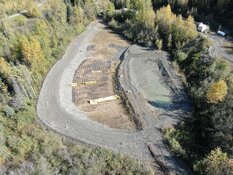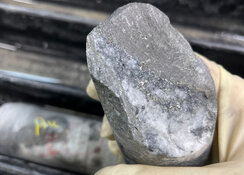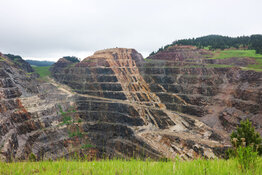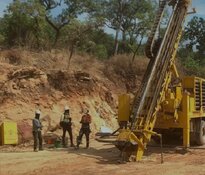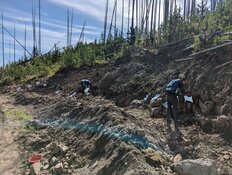The Gold Report: Sulliden Gold Corp.’s (SUE:TSX; SDDDF:OTCQX; SUE:BVL) September 2012 feasibility study on the Shahuindo project in Peru estimates an initial capital expense of $131.8 million ($131.8M) and operating costs of $552/ounce ($552/oz) to produce 90,000 oz gold for more than 10 years. The capital expense (capex) and operating costs seem relatively low. What makes this such a low cost operation?
Justin Reid: It's a number of things. First of all, we are located in Peru. The northern Peruvian gold belt is one of the lowest cost producing gold districts in the world with the likes of Newmont Mining Corp.'s (NEM:NYSE) Yanacocha mine, Barrick Gold Corp.'s (ABX:TSX; ABX:NYSE) Lagunas Norte and others. There are more than 10 mines in the region that demonstrate these very low operating costs.
As far as the low capex, the $132M is a result of our mineral deposit. It is an open-pit, heap-leach operation that is not capital intensive. Our ore body is very simplistic. At the end of the day, our pit will be approximately 5 kilometers long, 500 meters (500m) wide and only 95m deep. Imagine it as a scrape along the surface. Being a heap-leach operation, we also have limited earth works and infrastructure to build. One thing to note is that the $132M capex was a result of our 2012 feasibility study. We've been working very hard since then to optimize that number as we move toward construction.
For example, our feasibility study considers an owner-operated fleet; however, because of availability of contractors in Peru right now, we're likely going to be able to drop about $25–30M off that capex with a contractor model while keeping our costs about the same.
TGR: What is it about Peru that makes it so low cost?
JR: It's actually the morphology of the ore deposit. Shahuindo is a highly oxidized sandstone. The gold is very fine grained and interstitial within the porosity, which allows for incredibly good leaching. As an example, in Mexico, the standard leach cycle is 120 to 180 days for an open-pit, heap-leach mine with about 65% recovery on the high side. Because of the fine grain interstitial nature of our gold, our ore leaches incredibly well. This is very common in northern Peru; it's not unique to our deposit. At Shahuindo, we have a 40-day leach cycle during which we recover almost 90% of the gold. Eighty percent of that gold is recovered in the first 20 days.
TGR: In September you received approval from Peru's Ministry of Energy and Mines for Shahuindo's environmental impact assessment (EIA). What is the timeline for moving forward with construction?
JR: The EIA is the single most important permit we need in Peru. There are a number of other permits and authorizations needed, however they all funnel off of this main permit. It took our team over 18 months of work and they certainly did a great job. We're now in the process of working through all the process permits, such as blasting, access, construction, extraction, etc. We expect to have the majority of these permits in hand by the end of the year, so in the next two months or so. We remain on track to be in construction in the first half of next year. We're looking at a construction period of about 10 months and 2015 is targeted to be our first full year of production.
TGR: You already talked a little bit about the morphology of the ore deposit at Shahuindo; tell us about the workforce that Sulliden has in Peru and about the management team there.
JR: The majority of Peru's GDP is resource based, specifically mining. The mining sector has an incredibly industrialized, educated and well-trained workforce, especially in the Cajamarca region where we are located. Most major mining companies are represented in Peru or have an operation in Peru.
We have seen delays with Newmont's Conga project, and due to the current environment, a few expansions have been delayed as well, so a well-trained workforce is available. We're going to need fewer than 350 people on site and I don't believe we'll have a problem filling that from the large group of trained professionals in the area. We will likely have very few ex-pats on site and we expect almost all of the workforce to be local Peruvians simply because of the high level of skill.
The management team of Sulliden is small, but we have a lot of experience in exploration, development, construction, operations and on the financial side as well. Peter Tagliamonte, Sulliden's chairman and CEO, has more than 30 years of experience in the mining industry managing and building mines. He was head of Eldorado Gold Corp.'s (ELD:TSX; EGO:NYSE) Brazilian operations. He built Jacobina for Desert Sun, which was sold to Yamana Gold Inc. (YRI:TSX; AUY:NYSE; YAU:LSE), and also built Central Sun, which was sold to B2Gold Corp. (BTG:NYSE; BTO:TSX; B2G:NSX).
Peter has been able to keep the same operational and technical team together for more than 20 years. That team has moved with him. We've been very lucky at Sulliden that even though our current management team has only been working together since 2009, our operational and technical team has been together for more than 20 years and has a lot of experience both building and operating mines.
TGR: You mentioned that Newmont had suspended its Conga mining operations and there were some unutilized workers that you might be able to bring on. What caused Newmont to postpone the project?
JR: Conga has a $7+ billion ($7B+) capex and over the last six to eight months, we've seen a lot of major gold companies defer development costs of those large-sized projects.
Conga has been delayed because of economics and some social issues that are being worked through. In this environment a lot of these multibillion dollar development projects are being suspended or deferred. As such, there were going to be thousands of workers at that operation and a lot of that unused labor pool is available to us.
TGR: Sulliden's feasibility study indicates that the resource could be expanded. Sulliden has suggested it could tap 40% of the resource with the $132M capex. What can we expect in the future and what's the timing for the next catalyst?
JR: There have only been 150,000m drilled at Shahuindo to date. That is a small company's average annual drilling. From the drilling we have conducted so far, we have uncovered 4 million ounces (4 Moz) of gold resources, 2.5 Moz of oxide. We haven't drilled a single hole in two years. When we got to 2.5 Moz, we decided as a junior company to preserve our capital and move immediately to a feasibility study.
As we move into construction you can expect to see the drills start up again. We have significant extensions to our ore body, both along strike for kilometers and in a parallel zone, the north corridor, to the northeast of our deposit. We've barely touched the surface of this deposit. It's open in all directions. The exploration potential of our deposit for adding material ounces very quickly was one of the key reasons that Agnico-Eagle Mines Ltd. (AEM:TSX; AEM:NYSE) made its strategic investment in our company.
We will get the drills turning again when we move into construction early next year. The upcoming catalysts for the company will be in the next two and a half to three months when we complete our financing, roll in all our permits, and then get the exploration going again as we move into construction.
TGR: Turning to your financing, on Oct. 11 Sulliden successfully closed a $40M bought deal co-led by National Bank Financial and Scotia Capital. Are these funds going toward construction? And how much more money will you need for the completion of construction?
JR: The deal was very well taken and in the current environment we're very happy that it went so well. We have about $70M in the bank right now. We're looking to bring on contractors in our mine operation, which will save another $25–30M on our capex. What you'll see over the next couple of months is that we will roll in a debt package of between $50M and $60M, which will provide all the capital we need for construction.
We mandated Credit Suisse and Barclays last November for a $125M facility. Because of the optimization that we are doing and our current cash balance, we obviously won't need $125M, but we'll be able to finalize that over the next few months and bring in just enough to cover our development costs and working capital requirements during the construction and ramp-up phases. We are working through the due diligence right now and expect to have that finished very shortly.
TGR: What's your view right now about the financing market in general? Do you have the impression that things are improving? Is it getting easier to raise money than it has been in the past few years?
JR: It's still very, very hard in this market. The majority of midtier producers are currently trading below market value or below book value. We have yet to see a lot of new capital come into the market and that's really what we need. It's not a sector call right now for financing. It's really name specific. We find ourselves to be one of the top three performing gold stocks on the TSX this year because our team has quietly delivered on everything.
Those who are looking to invest in this sector are looking for very specific things. In our case, we delivered on the feasibility study; we're low capital intensity; we're not a $350B company trying to fund a $3B mine. We're a $300M market-cap company trying to fund a $100M project. We're not overstepping our abilities from a marketing standpoint or a financing standpoint.
We have a very strong management team and a $70M balance sheet. We're not going to have to dilute our shareholders materially to build this mine. We have a funding package in place that will have us fully financed and we've delivered on the permits. We've been able to execute on our story while keeping the balance sheet firm and we've been able to execute something that is within our scope.
I can't speak for other companies, but our average peer group is down 45% on the year and it's simply because of the market. There are great projects and great management teams out there, but unless there's something near term and tangible to focus on, it's tough to keep investors focused.
TGR: You were previously the managing director of global mining sales at National Bank Financial, as well as senior mining analyst of Cormark Securities. How has this experience helped with Sulliden's capital raising?
JR: I have a good understanding of the global mining market. I know all our major shareholders and also the resource investors in general, especially the institutions. Going through as many cycles as I have, I certainly understand where the market is and how the timing works. Knowing the shareholders, the markets, the brokers and the bankers helps me put all the pieces together and know when is the time is right to complete a financing.
We want more than anything for the financing to be successful and we want our shareholders to make money. That's why we're all here. Sulliden has been very, very lucky that our major institutional shareholders—and we're more than 70% institutionally held—are long-term supporters. As such they were very supportive of our deal, which certainly helped.
TGR: In April, Sulliden raised $24M for a private placement with Agnico-Eagle, which you mentioned before. Is a buy out from Agnico-Eagle a possible exit strategy once the Shahuindo mine is in production?
JR: Well, it's tough to say. The main driver for us was that Agnico-Eagle is known as an incredibly conservative and technically astute company. The company is considered one of the best operators in the business. There was a significant due diligence period for Agnico before it made the investment and it involved all facets of our company.
The validation of Agnico's investment was one of the most important things for us because it set us apart from a lot of our peers. Agnico has bought a lot of companies before and a lot of its growth profile has come from acquisitions, but at the same time it has also made investments and sold them. We certainly think that culturally we would be a good fit with Agnico and that's why we are happy to have Agnico as a major shareholder, but from our standpoint right now our focus is solely on building and operating Shahuindo and then growing the project beyond the initial feasibility study. What Agnico does we have no control over, but certainly the validation and support that it has given us has been great.
TGR: Is there anything else you'd like investors to know about Sulliden?
JR: The one thing I'd like to stress about our Shahuindo project is the simplicity and economics of this asset. It is located in one of the lowest cost and most prolific gold belts in the world and has a very low capex of approximately $100M. We have a very strong balance sheet.
Technically this is a very, very simple, open-pit, heap-leach, 90-meter deep pit. The costs are going to remain very low especially when considering the leach kinetics of the deposit. At a $1,300/oz gold price, Shahuindo, without any consideration for expansion, will deliver a post-tax internal rate of return (IRR) in excess of 33%. If we go with contract mining, the IRR would be north of 40%. The economics of the project are great and the technical risk of this deposit is very low. It's a very simple asset, which should give investors some confidence as we move forward.
TGR: One last thing, take out the crystal ball. Where do you see the price of gold going in the next year or so?
JR: If we look at the cost of production for gold right now, we are probably well below the marginal cost. In the next 8 to 12 months, we could see gold approach $2,000/oz again, which for Shahuindo and for our peers would be great. Our costs being sub-$550/oz and our all-in costs being below $850/oz, Shahuindo can make a great return for its shareholders even at $1,100/oz gold; however I certainly hope that gold isn't going that low. I see gold going to $2,000/oz quite easily.
Justin Reid was appointed president and a director of Sulliden Gold in February 2013. He is a geologist and capital markets executive with more than 20 years of experience in the mineral resource business. In 2011, he was named managing director of global mining sales at National Bank Financial where he directed the firm's sales and trading in the mining sector. Prior to that, he was named executive general manager of Paladin Energy in 2009. Before that, he was a senior mining analyst at Cormark Securities. He started his career as a geologist with SGS and Cominco Ltd. He has a Bachelor of Science degree from the University of Regina, a Master of Science degree from the University of Toronto and a Master of Business Administration from the Kellogg School of Management at Northwestern University.
Want to read more Gold Report interviews like this? Sign up for our free e-newsletter, and you'll learn when new articles have been published. To see a list of recent interviews with industry analysts and commentators, visit our Streetwise Interviews page.
DISCLOSURE:
1) Dan Lonkevich conducted this interview for The Gold Report and provides services to The Gold Report as an independent contractor. He or his family own shares of the following companies mentioned in this interview: None.
2) Sulliden Gold paid The Gold Report to conduct, produce and distribute the interview.
3) Sulliden Gold had final approval of the content and is wholly responsible for the validity of the statements. Opinions expressed are the opinions of Sulliden Gold and not Streetwise Reports or The Gold Report or its officers.
4) The interview does not constitute investment advice. Each reader is encouraged to consult with his or her individual financial professional and any action a reader takes as a result of information presented here is his or her own responsibility. By opening this page, each reader accepts and agrees to Streetwise Reports' terms of use and full legal disclaimer.
5) From time to time, Streetwise Reports LLC and its directors, officers, employees or members of their families, as well as persons interviewed for articles and interviews on the site, may have a long or short position in securities mentioned and may make purchases and/or sales of those securities in the open market or otherwise.


